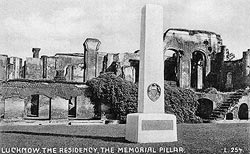A Variety of Stations
The river journey presented for the 31st an aspect of India not encountered by the Queen’s on the other side of the country. The regiment also experienced a greater variety of cantonments. One of the most impressive was at Dum Dum, outside Calcutta, which was built at the end of the 18th century by the East India Company for the Bengal Artillery. It was a large cantonment which included a number of fine public buildings including a church, reading rooms, an assembly hall and an imposing officers’ mess. The soldiers’ barrack rooms were single-storied buildings with deep verandahs and thatched roofs, set far apart to take advantage of any movement of air in the heat of summer.
 |
| Lucknow. The Residency, The Memorial Pillar. (Click to enlarge) |
Dinapore was a transit port for officers and soldiers going by water to join their regiments further up country. It was also a regimental base. The place was low-lying and unhealthy and the cantonment accommodation limited. It was described as consisting of two quadrangles with a road dividing them in the centre; these formed the barracks, each for a wing of a regiment, the remaining sides of the square being the quarters of the officers: the central area was a smooth greensward, used as a parade ground. The river flowed on the north of the whole, and within a few yards of the quarters on that side. The surrounding country was flat and uninteresting, and the village became flooded during the rainy season.
Nevertheless the officers enjoyed sailing on the Ganges, and there was also the Dinapore hunt, which had a pack of dogs of all sorts. John Greenwood recalled that “Every member was obliged to bring two dogs into the field, and we hunted every evening. Plenty of foxes were to be purchased at about a shilling apiece; and after all the dogs had been collected and taken down to a plain near the course, and the field assembled, we used to turn them out of their baskets, and great fun we had with them....In India everyone who can afford it keeps horses. Their keep costs nothing compared with the expense in England...The syce or groom runs after his master when he rides out in order to hold his horse whenever it may please him to dismount...I have seen them frequently keep up with a buggy for eight or ten miles when the horse has been going at a sharp trot.. The other servant is the grass-cutter. His business is to go out every morning into the country, and return in the evening with a sufficient quantity of grass for the next day’s consumption”. There was an annual horse fair not far from Dinapur to which thousands of horses were brought for sale from all parts of India during which horse racing took place. The horses generally belonged to officers and civilians from the neighbouring stations and local indigo planters. Most of the jockeys were Indian boys but there were some Europeans.
The regiment moved on to Meerut, the headquarters of a division of the Bengal Army, well situated to keep an eye on Delhi and to reinforce the north-eastern border should that be necessary. Poona and Meerut were both regarded as good stations, and Meerut, between Delhi and the Himalayan foothills, was a large one. Greenwood described it as “a very fine station, undoubtedly the best in India. The cantonments are very extensive, sufficient to accommodate six or seven thousand men, including a regiment of European cavalry, horse artillery and infantry. Smallpox is rather prevalent here, but generally the climate is not unhealthy. Shops for the sale of European wares of every description are large and numerous, and consequent on this competition the articles sold by them are at excessively moderate prices. All the officers’ bungalows have gardens attached to them in which far better vegetables and fruit may be raised than those that are proffered for sale in the bazaars. Mutton, beef, fowls etc are plentiful, of excellent quality and very cheap. There is plenty of wild fowl in the vicinity and the station is sufficiently near to the Himalayan mountains to render it an easy matter to ride up to Simla or some other hill station during the hot weather.” The soldiers’ barracks were also considered excellent. Each company had four detached buildings allotted to it with rooms for non-commissioned officers.
Related
